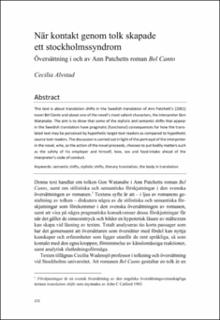| dc.contributor.author | Alvstad, Cecilia | |
| dc.date.accessioned | 2023-01-30T15:44:29Z | |
| dc.date.available | 2023-01-30T15:44:29Z | |
| dc.date.created | 2022-08-22T12:39:10Z | |
| dc.date.issued | 2022 | |
| dc.identifier.citation | Dahnberg, M. & Lindqvist, Y . (Red.). (2022). Tango för tre: En dansant festskrift till Cecilia Wadensjö. Stockholms universitets förlag. | en_US |
| dc.identifier.isbn | 978-91-983647-0-5 | |
| dc.identifier.uri | https://hdl.handle.net/11250/3047254 | |
| dc.description.abstract | This text is about translation shifts in the Swedish translation of Ann Patchett’s (2001) novel Bel Canto and about one of the novel’s most salient characters, the interpreter Gen Watanabe. The aim is to show that some of the stylistic and semantic shifts that appear in the Swedish translation have pragmatic (functional) consequences for how the translated text may be perceived by hypothetic target text readers as compared to hypothetic source text readers. The discussion is carried out in light of the portrayal of the interpreter in the novel, who, as the action of the novel proceeds, chooses to put bodily matters such as the safety of his employer and himself, love, sex and food-intake ahead of the interpreter’s code of conduct. | en_US |
| dc.language.iso | swe | en_US |
| dc.publisher | Stockholm University | en_US |
| dc.relation.ispartof | Tango för tre: en dansant festskrift till Cecilia Wadensjö | |
| dc.subject | semantic shifts | en_US |
| dc.subject | stylistic shifts | en_US |
| dc.subject | literary translation | en_US |
| dc.subject | the body in translation | en_US |
| dc.title | När kontakt genom tolk skapade ett stockholmssyndrom : Översättning i och av Ann Patchetts roman Bel Canto | en_US |
| dc.type | Chapter | en_US |
| dc.description.version | publishedVersion | en_US |
| dc.subject.nsi | VDP::Humaniora: 000::Språkvitenskapelige fag: 010 | en_US |
| dc.source.pagenumber | 172-186 | en_US |
| dc.identifier.cristin | 2044937 | |
| cristin.ispublished | true | |
| cristin.fulltext | original | |
